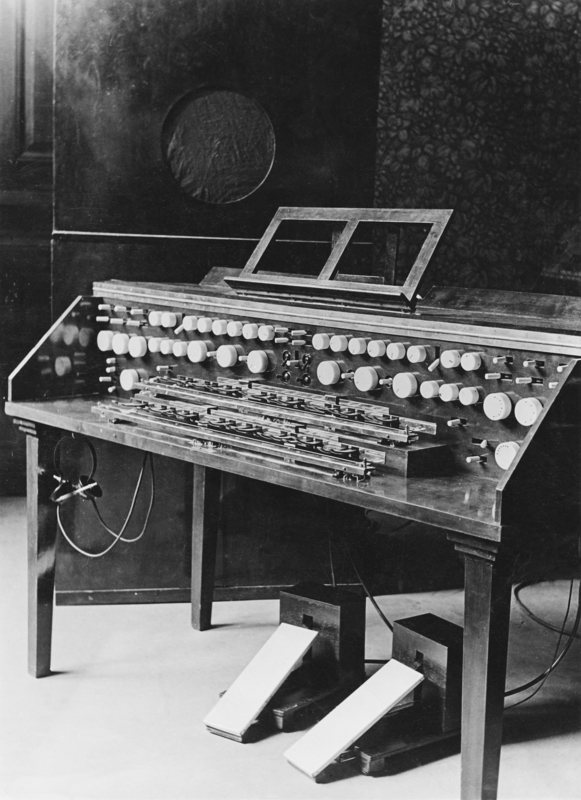The Trautonium on air
Following the National Socialists’ seizure of power in 1933, the Reich Broadcasting Corporation (Reichsrundfunkgesellschaft) commissioned a larger, more advanced Trautonium to serve the Reich’s propagandistic needs. Due to Trautwein’s appointment as professor of acoustics at the Academy, Sala independently undertook the development and completion of his first own construction: the Rundfunktrautonium.[5]
The most noticeable modification made is the addition of a second playing manual. This second manual helped Sala overcome two limitations of previous models at one go: the limited range and the monophonic nature of the single manual. Furthermore, he attached a pedal to each of the two manuals respectively. These pedals could transpose the manuals to a lower or higher register, thus further widening the span of the notes available to the player. Although Sala marked the three pedal settings with h (high), m (middle) and t (low) in his manuscripts, these were in fact activated by moving the pedals horizontally.
These innovations enabled Sala to take his performing capacities to the next level. He was offered his own radio programme entitled Musik auf dem Trautonium (Music on the Trautonium). On these weekly broadcasts which lasted roughly 15 minutes, Sala chose to perform neither Bach, Mozart nor Beethoven, but rather “always new and virtuosic [material], sometimes Busoni or Paganini, and especially original compositions, many of which were written by Harald Genzmer.”[6] His choice of repertoire here is unsurprising: Sala’s go-to showcase pieces were mostly works originally composed for string instruments. After all, the multi-voiced polyphonic complexities and harmonic intricacies of Bach, Mozart and Beethoven’s music (especially their keyboard music) would have not been playable due the limitations of the Rundfunktrautonium’s two monophonic manuals. Moreover, Sala’s motivation behind installing the second manual was more to “perfect the playing of a [single] melody [line]” rather than to execute complicated multi-voiced polyphony.[7]
From registral expansion to early subharmonics
Sala had already began experimenting with opportunities to widen the sonic capacities of the Trautonium in experimental models preceding the Rundfunktrautonium. Spurred on by his encounter with Arnold Schoenberg in 1930, who was less than impressed with the limited tonal range of the Trautonium, Sala installed two sets of three extra knobs on the Trautonium,[8] which would enable him to tune his instrument to a higher and lower register respectively. The three registers – high, low and the original middle – were accessed via a switch. Hindemith composed Konzertstück für Trautonium und Streichorchester especially for this enhanced instrument. Sala performed this piece on his registrally expanded Trautonium at the 1931 Tagung der Rundfunkfachleute (broadcasting congress).
Paul Hindemith: Konzertstück für Trautonium und Streichorchester
Featured in Oskar Sala: Elektronische Impressionen
CD, Erdenklang, 1998.
Original recording from 1977 by Oskar Sala on the Mixturtrautonium, with the Munich Chamber Orchestra conducted by Hans Stadlmair.
Individual pieces:
1. Leicht bewegt
2. Lied, ruhig bewegt
3. Im ersten Zeitmaß
Additionally, Sala had equipped the Rundfunktrautonium with two elementary subharmonic mixture circuits, which Hindemith found highly interesting: “Early August 1935. Slow piece and rondo for Trautonium. Written for Sala. An interesting task, as recently, the Trautonium can be treated as a four-part instrument, but only in such a way that each of the two parts is coupled with the 2nd, 3rd, 4th or 5th notes of the subharmonic series (octave, twelfth, second octave, and a third below that); despite the severe limitations, the interweaving of the two coupled series yields unusual possibilities.”[9] In 1985, Sala reconstructed the Slow Piece and Rondo for Trautonium based on an original recording he had sent to Hindemith in America shortly after the war.
Paul Hindemith: Langsames Stück und Rondo für Trautonium
Featured in Oskar Sala: Subharmonische Mixturen
CD, Erdenklang, 1997.
[5] Brilmayer notes that this parting of ways may also be due in part to a minor rift between Sala and Trautwein. Benedikt Brilmayer, Das Trautonium. Prozesse des Technologietransfers im Musikinstrumentenbau, PhD Dissertation, Augsburg 2017, accessible online via https://opus.bibliothek.uni-augsburg.de/opus4/frontdoor/index/index/docId/4059, p. 280.
[6] Martin Demmler, ‘Die Wiederentdeckung des Trautoniums: Der Trautonium-Virtuose und Elektronik-Pionier Oskar Sala feiert seinen 90. Geburtstag’, in: Das Orchester 48 (2000), pp. 26–30, here p. 28. Unless otherwise stated, translations from German into English are provided by the author of this exhibition.
[7] Oskar Sala, ‘Ein neues elektrisches Soloinstrument‘, in: Neues Musikblatt (May/June 1938), pp. 5–6, here p. 5.
Citation: Julin Lee, ‘Subharmonic Fantasias: The Legacy of Oskar Sala and the Mixturtrautonium’, in: Materiality of Musical Instruments. A Virtual Exhibition.

